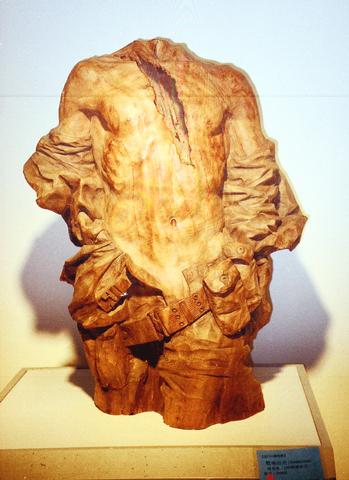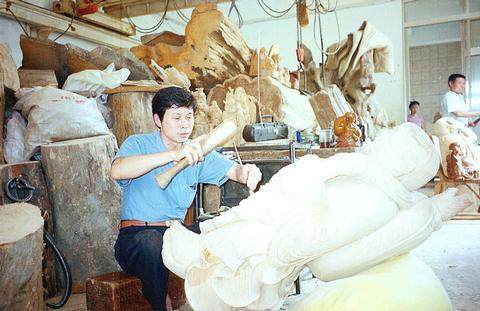The normally sleepy town of Sanyi (三義), Miaoli County (苗栗縣), got a jolt this weekend when the annual Sanyi Wood Carving Festival (三義木雕節) got off to a thunderous start. The pounding of drumming teams performing at the opening ceremony, the din of cars and buses vying for parking slots and the incessant buzz of the wood carvers' tool, the chainsaw, reverberated throughout the small town on Saturday.
Residents of Sanyi and visitors from across the country were joined by Premier Chang Chun-hsiung (張俊雄) and Minister of Transportation and Communications, Yeh Chu-lan (葉菊蘭) for the nine-day festivals' noisy opening ceremony. All were treated to spectacular performances by Hakka dragon dance teams and Aboriginal folk dancers from Sanyi.
So as to remind visitors that the festival is a celebration of woodcarving rather than of political rhetoric and dragon dancers, a couple of the towns' more enterprising resident woodcarvers took the extraordinary step of taking their chainsaws to a huge block of ice. The aim being to carve an ice dragon before the blistering heat of the noonday sun melted all the ice. The stunt proved a huge success. Not only did it attract crowds of curious onlookers the carvers also managed to complete the icy dragon before the ice melted.

PHOTO: GAVIN PHIPPS, TAIPEI TIMES
It was, of course, the woodcarvers themselves who drew the biggest crowds on the day. Even the premier made time to drop by one store for a chat and to watch as woodcarver, Hsiao Chin-lien (蕭進連) began work on a new carving.
For wood carvers such as Hsiao, the annual festival is an opportunity to demonstrate the carving techniques and prowess which has enabled the Sanyi wood carvers to become possibly the finest, and certainly the quickest, wood carvers in the world.
The town is in fact one of the oldest known centers of camphor woodcarving in Asia. Historical records and artifacts show that the town of Sanyi has a tradition of woodcarving dating back over 400 hundred years. Aborigines originally used the gnarled trunks and roots of local camphor trees as a base for their carvings.

PHOTO: GAVIN PHIPPS, TAIPEI TIMES
While the town saw an influx of art students keen to learn the art of woodcarving from the 1920 onwards, it wasn't until the 1970s that the town's woodcarving tradition went global. Works by local woodcarvers such as Yang Cheng-yu (楊正育) and Chien Ming-kunag (簡明光) found their way to Taipei and in turn onto the international market. Like many of his peers, Hsiao also suddenly found himself carving works not only for the local market but also for export to Korea, Japan, Thailand and the US.
"I started woodcarving over 30 years ago and was soon getting orders from Thailand and Japan. My father was a woodcarver and so was his, but neither of them had any opportunity to export their works. I can't really explain why there was a sudden interest in our woodcarvings in the 1970s, but I guess it had more to do with the art dealers in Taipei than with us. After all, people have been carving sculptures out of camphor here for too many years to remember," explains Hsiao while meticulously shaping the eyeballs on a half-finished carving of a pot-bellied Buddha. "Since then the number of pieces I make for export has increased so much that I'm now getting orders from the US, Korea and even Europe. And then there's the local market. I don't think I've been busier."
It was in the mid-1990s that Sanyi became more than simply a point on a map and became the center of the nation's woodcarving industry, attracting art lovers and collectors from around the world. By the time the Sanyi Museum of Wood Sculpture (三義木雕博物館) opened its doors in 1995, the town had come to the attention of well-known artists including Ju Ming (朱銘). The artist has since donated several of the wood sculptures he created while working in Sanyi to the museum.
Of course, while the town has prospered, the local camphor tree population has dwindled. Which is why local woodcarvers are now required to purchase their wood from registered dealers located in Alishan (阿里山) and Ilan (宜蘭), where camphor trees are protected and strict records are kept of logging. According to Hsiao, illegal logging does take place, but he says the scale of such logging is still relatively small.
Purchasing a work carved out of illegally felled wood is the least of the quandaries facing any tourist to Sanyi at present, however. In recent years the number of stores packing their shelves with cheaper camphor carvings made in China and selling them to unsuspecting tourists rather than the more expensive local products has increased dramatically. Sanyi wood carvers, however, don't feel their livelihood is under any immediate threat.
"It's not a big problem at the moment. People still come here to buy locally made products even though the imported sculptures are cheaper. When people come here they want to take home a piece of Sanyi, not Fujian Province, where most of the cheap carvings you see here come from," Hsiao said.
"Sanyi has been the center of woodcarving for hundreds of years and it's not simply going to disappear because of this. [Sanyi] will always attract people who are after unique and well-crafted wood carvings. The town is growing and the festival gets bigger every year. What more proof do you need?"
While the museum is the focal point of the festival, other activities spill out onto the streets of Sanyi. The plaza adjacent to the museum will play host to a series of special wood sculpture exhibitions and performances. And in addition to the numerous woodcarving stores that litter the town, local carvers and collectors can be found in the parking lot of the West Lake Resortopia (西湖渡假村) and both selling carvings and giving demonstrations of carving techniques.
What: Sanyi Wood Carving Festival (
Where: Sanyi, Miaoli County (
When: Until Wednesday, June 3
Contact the Tourism Bureau at tel: (02) 2349-1700 for more information about the event.

In the next few months tough decisions will need to be made by the Taiwan People’s Party (TPP) and their pan-blue allies in the Chinese Nationalist Party (KMT). It will reveal just how real their alliance is with actual power at stake. Party founder Ko Wen-je (柯文哲) faced these tough questions, which we explored in part one of this series, “Ko Wen-je, the KMT’s prickly ally,” (Aug. 16, page 12). Ko was open to cooperation, but on his terms. He openly fretted about being “swallowed up” by the KMT, and was keenly aware of the experience of the People’s First Party

Aug. 25 to Aug. 31 Although Mr. Lin (林) had been married to his Japanese wife for a decade, their union was never legally recognized — and even their daughter was officially deemed illegitimate. During the first half of Japanese rule in Taiwan, only marriages between Japanese men and Taiwanese women were valid, unless the Taiwanese husband formally joined a Japanese household. In 1920, Lin took his frustrations directly to the Ministry of Home Affairs: “Since Japan took possession of Taiwan, we have obeyed the government’s directives and committed ourselves to breaking old Qing-era customs. Yet ... our marriages remain unrecognized,

Not long into Mistress Dispeller, a quietly jaw-dropping new documentary from director Elizabeth Lo, the film’s eponymous character lays out her thesis for ridding marriages of troublesome extra lovers. “When someone becomes a mistress,” she says, “it’s because they feel they don’t deserve complete love. She’s the one who needs our help the most.” Wang Zhenxi, a mistress dispeller based in north-central China’s Henan province, is one of a growing number of self-styled professionals who earn a living by intervening in people’s marriages — to “dispel” them of intruders. “I was looking for a love story set in China,” says Lo,

During the Metal Ages, prior to the arrival of the Dutch and Chinese, a great shift took place in indigenous material culture. Glass and agate beads, introduced after 400BC, completely replaced Taiwanese nephrite (jade) as the ornamental materials of choice, anthropologist Liu Jiun-Yu (劉俊昱) of the University of Washington wrote in a 2023 article. He added of the island’s modern indigenous peoples: “They are the descendants of prehistoric Formosans but have no nephrite-using cultures.” Moderns squint at that dynamic era of trade and cultural change through the mutually supporting lenses of later settler-colonialism and imperial power, which treated the indigenous as